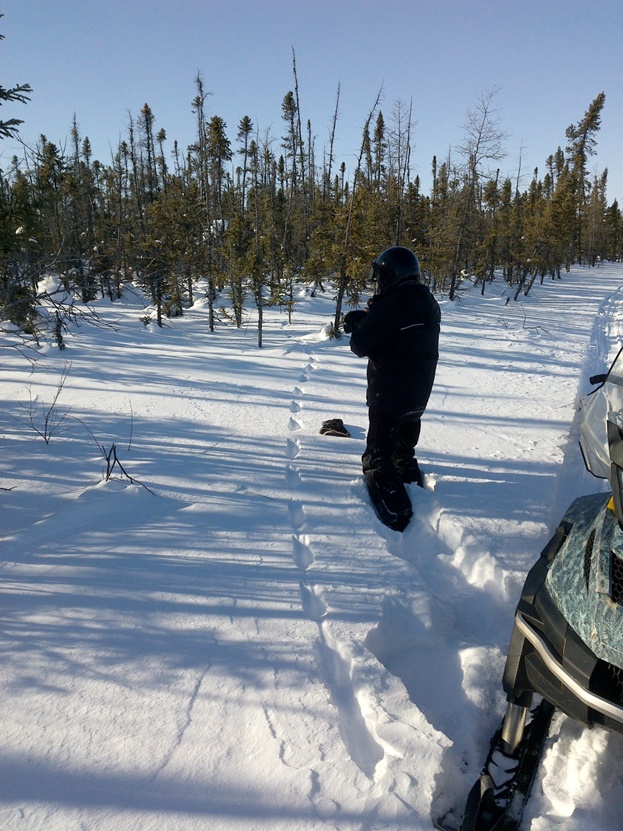2014-2021 Winter Track Surveys
Communities, government and industry have all expressed interest in monitoring the cumulative impacts of oil and gas exploration activity and other natural factors on wildlife within the Sahtú region. The Cumulative Impacts Monitoring Program (CIMP) has provided funding to start a collaborative wildlife monitoring program entitled "Multi-species monitoring using winter wildlife track surveys in the Sahtú Settlement Region" that uses surveys of wildlife tracks in the snow to measure changes in abundance and distribution of species such as boreal woodland caribou, moose, wolves and other furbearers such as marten and lynx. Further funding was secured from the NWT Environmental Studies Research Fund to continue the program from 2017-2021. The territorial government, Sahtú Renewable Resources Board (Ɂehdzo Got'ı̨nę Gots'ę́ Nákedı), and Tulı́t’a and Norman Wells Renewable Resource Councils (Tulı́t'a Ɂehdzo Got'ı̨nę and Tłegǫ́hłı Renewable Resources Council) have been partners on this project. Explor also provided track survey data collected during their Tulita seismic survey program in 2012 and 2013. Track surveys are conducted by teams of youth and elders along trails and seismic lines around each community. A mobile data collection app (Trailmark) is used to record tracks on handheld computers using a series of standard questions, along with coordinates, photos and audio recordings associated with each track.

Photo: William Horassi recording a Mink track along the trail to Willow Lake (Credit: GNWT-ENR)
This project will provide maps of where wildlife tracks are seen on the land, and information describing the habitat at each track observation. By repeating the surveys along the same trails and seismic lines over many years we will measure whether wildlife abundance and distribution is changing and if there is a link to the amount of industrial activity, forest fires and other human activity in different areas. This will help wildlife and land managers to understand the combined impacts of industrial development and natural disturbances and help to guide decisions about land use and wildlife harvesting.
Team Members
- James Hodson, Environment and Natural Resources, GNWT (This email address is being protected from spambots. You need JavaScript enabled to view it.; Phone: 867-767-9237 ext. 53227; Fax: 867-873-0293)
- Stephanie Behrens
- Kevin Chan, Environment and Natural Resources, GNWT(This email address is being protected from spambots. You need JavaScript enabled to view it., Phone: 867-587-3518)
- Tulita track surveyors: William Horassi, Jonathon Yakeleya, Philip Clement, Robert Horassi, Joanne Krutko, Dion Lennie, and Joseph Ayah; field work coordination provided by Roy Desjarlais.
- Norman Wells track surveyors: Christopher Brass, Bryson Rogers, Stuart Pope, Norm Hodson Jr., Brian Leblue, Kaden Lennie, Jaryd McDonald and Harold McDonald
- Jessie Tigner, Explor (This email address is being protected from spambots. You need JavaScript enabled to view it., Phone : 403-263-5950, Fax : 403-269-5252)
Funders
- Cumulative Impacts Monitoring Program (CIMP)
- NWT Environmental Studies Research Fund (NWT-ESRF)
- Environment and Natural Resources, GNWT
Reports
NWT Environmental Research Bulletin:
http://sdw.enr.gov.nt.ca/nwtdp_upload/128-CIMP_Bulletin_v3i15_press.pdf
Final Project report for CIMP:
2017-2018 ESRF Annual Report
https://www.nwt-esrf.org/sites/default/files/2018-08/2017%202018%20ESRF%20Annual%20Report.pdf
Other reports and presentations:
Search for “CIMP162” on the NWT Discovery Portal http://nwtdiscoveryportal.enr.gov.nt.ca/geoportal/catalog/main/home.page
Total Budget
~$75,000 / yr



 Phone: 867-374-4040
Phone: 867-374-4040 Email:
Email: